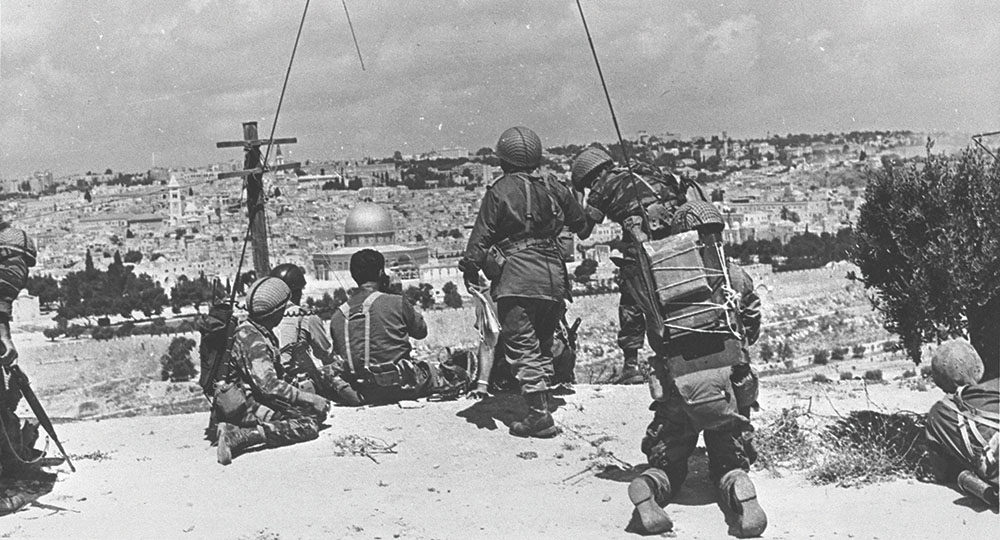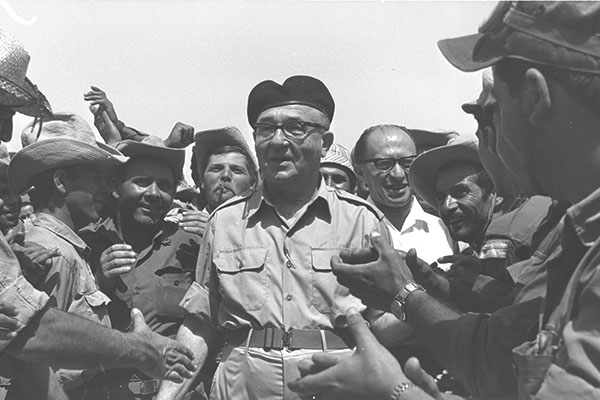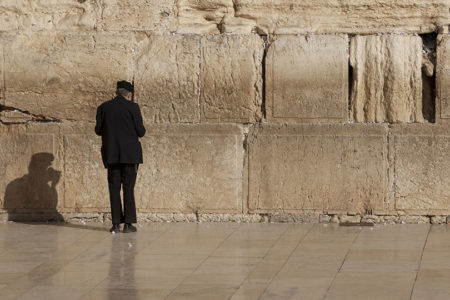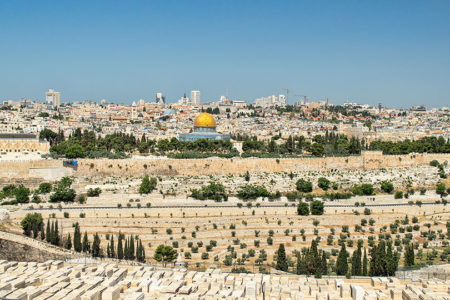Reunified Jerusalem: Twenty-Five Years and Counting
It has been 25 years since those battle-begrimed young paratroopers stood looking up at the Western Wall, the last artifact of the Herodian Temple. Their faces graphically mirrored the awe engendered in the heart of Jewry as they stood before the wall referred to by a prominent Israeli of that day as “our place of places.” There was a look of relief on their faces too, because on that day Jewry sensed, as did much of the rest of the world, that something; momentous had happened—something that gave rise to the hope that things would be all right now. The two thousand-year trek of foot-weary Jews across inhospitable nations had finally come to an end. The waves of successive Aliyah (ascenders) who had followed circuitous paths back to the land had finally reached Israel’s high place—the Temple Mount and the ancient city of their fathers. The Wandering Jew finally had a place to go; he could go home!
Jewry’s passion for the city of Jerusalem is something difficult for most Western minds to comprehend. For two millennia, Jewish families have gathered around Passover tables in disparate parts of the world and intoned their hope of hopes: “Next year, in Jerusalem!”
The hope of returning to the beloved city has been memorialized in the words of “Hatikvah” (our hope), Israel’s national anthem.
So long as still within our breasts
The Jewish heart beats true,
So long as still toward the east
To Zion looks the Jew,
So long our hopes are not yet lost—
Two thousand years we cherished them—
To live in freedom in the land
Of Zion and Jerusalem.
Ancient Jewish rabbis viewed Jerusalem as the precise center of the earth. “The world,” they say, “is like an eye. The white of the eye is everything else. The iris is Israel. The pupil is Jerusalem. But, ah, the gleam in the center of the pupil, that is the Temple Mount—that is Mount Moriah.”
Thus it was that at 9:40 a.m., Wednesday, June 7, 1967, Israeli paratroopers altered history. The hope born of desperation and fanned through two thousand years as they suffered debilitating dispersion was now attained—wonder-struck Jewish paratroopers were standing on the Temple Mount. And, to Jews the world over, the “gleam in the center of the pupil” was shining forth around them for all the world to see! On June 27, 1967, Israel officially annexed the Old City and began the long-sought task of reclaiming the city of their fathers.
Reclamation of the Old City was an immense task. The years of Jordanian occupation had wreaked havoc on what had historically been the Jewish sector of Jerusalem. Muslim animosity toward the Jewish presence had been vented by destroying Jewish synagogues in the quarter. The base of the relic, the Western Wall, revered by Judaism as the last remnant of their Temple, had been made into a receptacle for animal dung. Jews had, for 19 years (since 1948), been driven and fenced out of the sector where the historic Jewish presence had endured over the centuries. Tearing down those fences was a symbolic act, one that demonstrated the determination that, for all the days to come, Jerusalem would be a city open to all. Jew, Christian, and Muslim alike could come to their holy places unmolested. The new Jerusalem would be an open city—Jewry has kept its word.
It is doubtful that any city in the world has had more love lavished upon it than has Jerusalem over the past 25 years. People sometimes wonder why those who go there to visit wish to return year after year. Many reasons can be given, of course, but one compelling factor is clearly evident. The beautification of the city, which has continued across the years, draws one like a magnet. Mayor Teddy Kollek has led world Jewry in the effort to transform Jerusalem from a place of shabby, narrow streets, rock-strewn lots, and garbage-infested alleys to a city reflecting the glories embodied in psalm, hymn, and story across the centuries.
An Act of the Heart
Israel’s enemies have stridently continued to raise the accusation that the things Israel is doing in Jerusalem are little more than wanton acts of aggression designed to blot out Muslim identity. While it is true that Jews, with just and historic claim, wish to identify with Jerusalem and have the city properly reflect its Jewishness, endeavors there go far beyond anything politically or spitefully motivated. To the contrary, what is unfolding between Jerusalem and its Jewish sons and daughters is more of a love story, for there is something inexplicably etched in the Jewish heart that demands a presence there. Jews are bonded to the place in a tenacious demonstration of union, passion, and permanence—in other words, the best of everything genuine that love embodies. And this is not the exclusive domain of religious Jews; it is inflexibly resident in the vast majority of Jewish people regardless of their religious persuasion.
So they dig there. Jewish archaeologists sift ancient ruins down to bedrock in search of Jewish origins. They are there in profusion—Solomon’s city, David’s city, the city streets where Jesus walked. Long centuries before Islam was a flicker in Muhammad’s mind, the Jews were there.
Jews build there. The reclamation of the Jewish quarter of the Old City is a tribute to the tenacity and commitment to permanence that links Jewry to the place. Jerusalem stone, once only a segment of the landscape, is transformed daily into beautiful edifices that have changed the skyline of the city of David.
Abraham’s sons and daughters plant there. Reforestation, parks, gardens, and flower-strewn hillsides grace the eyes of those who come to the city. Indeed, one of the premier experiences of the visitor to Jerusalem is spending an hour on one of her hillsides planting a tree or shrub that will grow as a memorial to having walked there.
Israel invites the world to come and see her. While tourism represents a major element in the economy of Israel, the invitation involves much, much more than income. Christians can come to be spiritually refreshed at their empty Garden Tomb and walk in the places where the Savior ministered and purchased our redemption. Muslims are free to come to their El Aksa Mosque and the Dome of the Rock to share prayers and listen to Islamic sermons. Jews are urged to come, see, and leave a bit of themselves, or to stay and become one more son of Abraham to experience the dream of living in peace upon the hills of “Zion and Jerusalem.”
Shadows on the Hope
As Israel celebrates its 25th year of reunion with the city that holds her heart, we will hear intoned with perhaps more passion than ever before, “We are here to stay!” At present, there seems to be a Masada-like determination among the vast majority of Israelis, and Jews around the world, that Jerusalem will never again fall into the hands of interlopers. As Masada stands as a symbol of the nation’s commitment that Israel will not fall to her foes—“Masada shall not fall again!”—Jerusalem stands as an enduring symbol that Jewry’s heart and home are in the right place—the City of Peace, the City of Shalom.
But most of the world does not agree, and nations, including the United States, have demonstrated their displeasure by refusing to recognize Jerusalem as the legitimate capital of the State of Israel. Islam lays claim to Jerusalem, and the major powers’ increasing penchant for coddling Muslim enemies of Israel and, for that matter, of the West will assure the growth of controversy over the right of dominion in Jerusalem.
The question, however, reaches beyond the Islam/Israel conflict. It is rooted in a desire as old as the creation of nations, particularly Israel with her glowing biblical promises granting Jews a land in perpetuity.
When the United Nations on November 29, 1947, voted to grant Jews a portion of their homeland in the Middle East and to recognize the legitimacy of the tiny state under international law, Jerusalem was declared an international city. This would, of course, imply that the city of Jerusalem would be under the control of the United Nations, and their role would be to oversee affairs in the city and stifle the passions of the various elements representing the tapestry of religions resident in the area. The point is that a Gentile world body, the United Nations, was determined to exercise control over Jerusalem. That desire has not changed one iota with the rush of euphoric enthusiasm rolling in with the declared “new world order” so popular among politicians at the moment. And one can be assured that if and when the question of rights in Jerusalem is addressed during any future peace negotiations, the United Nations will insist on internationalizing the city, thus keeping it under their control.
If this scenario sounds all too familiar, it is. Jerusalem, rightfully the city of the Jews, has been prized by virtually every significant Gentile power that has ascended since she rose from the dust of the Judean hills. Today, every major political element (and many smaller ones) on the international scene feels that it holds vested interests in the Middle East and the fate of Jerusalem. During the Cold War, Israel and Jerusalem were seen as the democratic buffer against Communism in the region. Communists themselves dreamed of seizing Israel and Jerusalem. The consistent obsession reflects the biblical reality. The Lord said, “Behold, I will make Jerusalem a cup of trembling unto all the peoples round about” (Zech. 12:2). In other words, the nations will attempt to lay hold on Jerusalem, and she will prove to be a trembling cup in their hands—an emblem of disaster. “And in that day,” He went on, “will I make Jerusalem a burdensome stone for all peoples; all that burden themselves with it shall be cut in pieces though all the nations of the earth be gathered together against it” (Zech. 12:3). This has been true of Gentile nations across the centuries. The context of Zechariah 12 speaks of the final day when “all the nations of the earth be gathered together against it [Jerusalem]” (Zech. 12:3).
Jesus said in Luke 21:24, “Jerusalem shall be trodden down by the Gentiles, until the times of the Gentiles be fulfilled.” This states clearly that in the last gasp of the last days, control of Jerusalem will once again be wrested from the Jews, and they will be in their beloved city at the sufferance of Gentile overlords, namely the infamous Antichrist named in both the Old and New Testaments as the last human antagonist of Israel and the Jewish people. In short, the Bible teaches, and history increasingly affirms, that the clouds of battle are forming above Jerusalem, and one day the storm will break with sound and thunder the like of which the world has never heard.
Prepare to Meet the Messiah
While one must candidly say that there are shadows clouding the present hope for Jewry to live in peace upon the hills of Zion and Jerusalem, there is a magnificent silver lining to be seen. It is everywhere in evidence in Israel and Jerusalem at this very moment.
If you travel in Israel today, you will soon be asking about the large yellow and red banners seen along the roads, on illuminated signs atop cars, at the Wailing Wall, and on buildings in Old Jerusalem. The signs urge Israelis to prepare for the coming of the Messiah. And if the vast majority of Israelis are not heeding the advice emblazoned on those gaudy banners, it is not because they have not been told. Although neither we nor the vast majority of Israelis would agree with the theology of the ultra-Orthodox elements who placed those signs, they have hit upon the point of the entire issue at stake in Jerusalem.
You see, the issue of control of Jerusalem is not simply Gentile nations against Jewish dreamers. Jerusalem is the city of the King! God is sovereign over His eternal city. And the Messiah-King will one day come to His city, “And his feet shall stand in that day upon the Mount of Olives, which is before Jerusalem … And the Lᴏʀᴅ shall be king over all the earth” from Jerusalem (Zech. 14:4, 9).
For those who will heed the call to prepare to meet the Messiah, Jesus, there will be a grand celebration to enjoy. Reconciled Israel will have her city—just as He promised. And 25 years will pass as quickly as a dream interrupted by a new morning. Jerusalem, the golden city, will be the shimmering possession of her sons and daughters forever, and forever, and forever!








